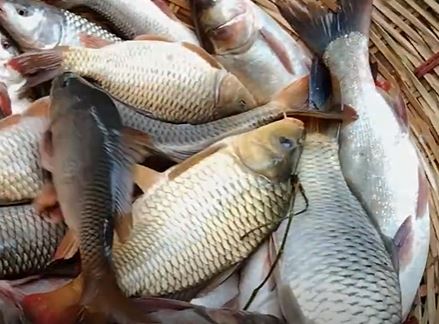
By Rafiqul Islam
DHAKA, Dec 21, 2021 (BSS) - Fisheries sector visibly reappeared in Bangladesh's cultural landscape with its efforts to restore the nation's "machhe-bhate Bangali" or "fish-rice" tradition as fish production nearly doubled in the past 12 years.
According to fisheries department officials, fish now accounts for 60 percent of riverine Bangladesh's protein demand, against 17 percent of the global average, as fish reappeared as the Bengalis ancient food item.
"On the eve of 50th anniversary of the independence we are now self-sufficient in fish production . . . Fisheries sector has emerged as one of the most productive and dynamic sectors of deltaic Bangladesh economy," Fisheries and Livestock Minister SM Rezaul Karim said.
Talking to BSS, he said the sector witnessed revolutionary changes in the last 12 years which he attributed to various government initiatives including the adoption and proper implementation of the Fisheries Act.
"Establishment of fish sanctuaries and beel nurseries, release of fish fry, proper management of marine fishery resources, development of fish landing centres and improved management system for inland open water are contributing to the increasing fish production," he said.
Karim said extra attentions were given for conservation of mother and juvenile hilsa resulting in its higher yield as Bangladesh is the largest producer of the fish of this particular species.
Fisheries department officials said the sector continued to witness over five percent growth in the last 12 years while the government set a target to enhance both the "culture" or "cultivation" and "capture" or open water fisheries by 20 percent within 2025.
"We set a goal in the eighth Five Year Plan (2021-2025) to increase overall fish production by 20 percent in next four years taking different initiatives," Department of Fisheries (DoF) director general Quazi Shams Afroz told BSS correspondent Rafiqul Islam.
In 2020, UN-Food and Agriculture Organisation (FAO) report on State of World Fisheries and Aquaculture, Bangladesh ranked third in open water or capture water fish production and eighth and 12th in crustaceans and finfish production.
Bangladesh was declared self-sufficient in fish production in 2016-17.
According to official data, the fisheries sector contributes 3.5 percent to Bangladesh GDP, while about 26 percent of the country's total agriculture income comes from the fisheries sector.
DoF director Azizul Haque said fish cultivation now accounted for 57.38 percent of consumed fishes while some 27.72 percent were coming from rivers and open waters and the sea providing the rest 14.9.
He said Bangladesh consumed and exported over 45.52 lakh tonnes of fish in 2020-2021 while the production volume was increasing every year at a steady rate of five percent.
DoF officials listed their steps for enhanced fish production as expansion and modernization of fish farming, promotion of environment-friendly shrimp cultivation, intensified campaign for hilsha conservation, protection of fish sanctuaries and wetlands for better fish habitats and breeding grounds.
The precious hilsha is produced only in 11 countries while Bangladesh tops their list in terms of its availability while DoF officials said they were proceeding with a calculated target to boost production of the species as well.
The DoF statistics showed that Bangladesh produced 5.5 lakh tonnes of hilsha in 2020-2021 while independent researchers expect the figure could be increased over 7 lakh tonnes if the fish species could be protected during it pre-mature stage spearheading an intensified conservation campaign.
"We are simultaneously working to save critically vulnerable fish species through fish sanctuary management," Haque said.
DoF statistics suggests that fisheries sector is the direct or indirect livelihood means of some 1.95 crore people or 12 percent of the country's population, 14 lakh of them being women.
The data shows the sector creates scopes of livelihood for about six lakh people every year, indicating the sector's growth.
"We have set as well a target to increase fishermen and fish farmers' income by 30 percent by 2025 under different initiatives like offering technical services to farmers and entrepreneurs," Haque said.
DoF officials said under Prime Minister Sheikh Hasina's directives fisheries sector was incorporated as a key arena Vision 2021 and Vision 2041 while she referred to Father of the Nation Bangabandhu Sheikh Mujibur Rahman's fascination for fish and aspiration for the sector's development.
"Prime Minister Sheikh Hasina's government continued to adopt appropriate conservation, development and sustainable production policies and strategies for the promotion of fisheries," the fisheries minister said.